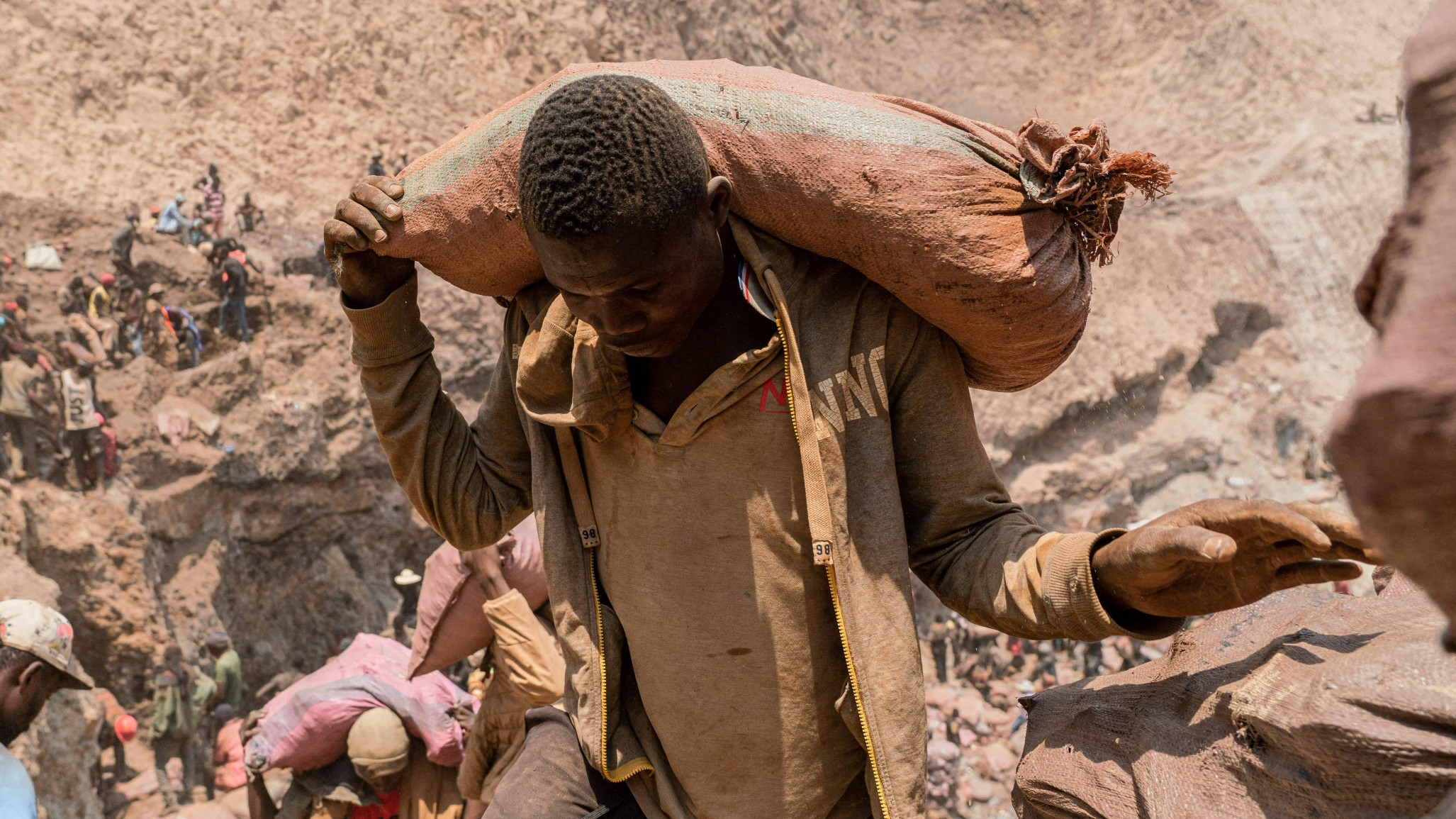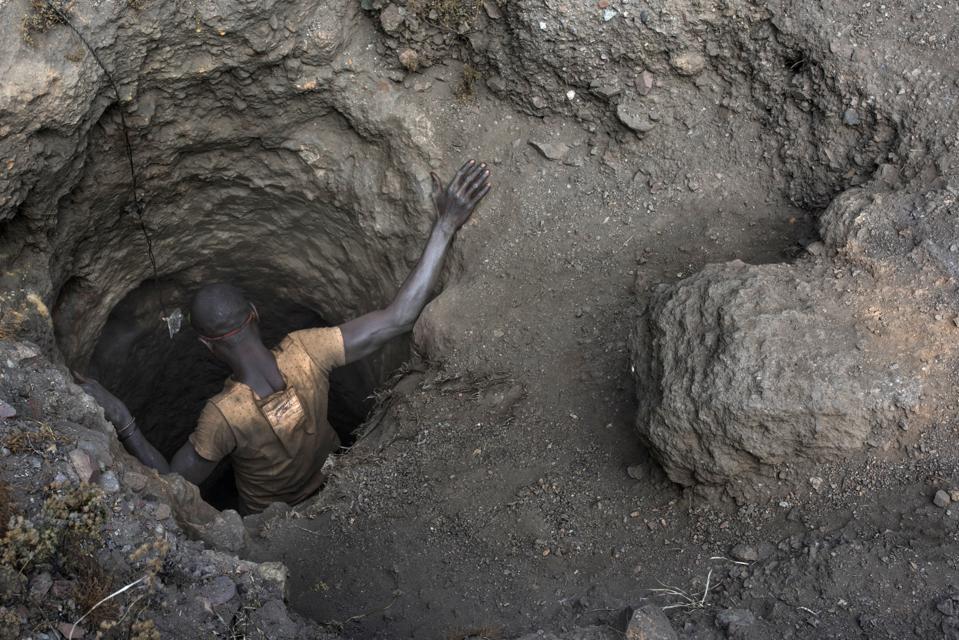‘A child died in the dirt so that your phone could charge‘ this was the opening statement of a video by Jermaine Fowler, a public historian and NYT bestselling author as he narrated the tragic events of September 2019, in Kamilombe, Congo, when a tunnel collapsed and swallowed child cobalt miners alive. As parents dug through the dirt to find their children, they recounted the hazardous nature of the industry where nearly 40,000 child workers are forced to mine for $1 or $2 per day, ‘killing the child inside them‘.
The Democratic Republic of Congo, situated in the heartland of Africa, is the home of nearly 70% of the world’s cobalt reserves and is projected to supply 225,000 metric tonnes of cobalt by the end of 2025. Cobalt is also known as the “blood diamond of batteries”. Congo, today, is barely given any space in historical discourse: its fate, an outcome of the collective global apathy to the unequal development patterns that prioritised the global north over the south, pushing the latter to the brink of catastrophic poverty and exploitation.
All over the world, the global demand for rechargeable batteries powering mobile phones, laptops and tablets is driving the extraction of cobalt, a key component of lithium-ion rechargeable batteries. Since DRC is the leading supplier of this vital natural resource, it has become the fulcrum point of human rights abuses, child labour, hazardous working conditions and environmental degradation linked to brutal resource extraction at the behest of the developed west.
Despite the cataclysmic crisis unfolding in this region, the mainstream media has abstained from shedding any light onto it, with the DRC sinking deeper into an unending cycle of inequality and exploitation. Yet, the world continues to watch the crisis, behind the comfort of the very screens that lit up because a child died while mining for the cobalt that could keep it running.
The silent crisis of Congo
The Congo crisis is rooted in a complex web of corporate complicity, capitalism and surplus resource extraction in the post-colonial era. The demand for greener technology and cleaner fuel, which was supposed to bring greater equality and ecofeminism, by contrast, ended up having reverse effects in the African state, where a shift to cleaner energy fuelled the demand for cobalt resource extraction. Cobalt mining often exploits children and poses severe health risks including outbreaks of Ebola, cholera, and other contagious diseases apart from several deadly forms of cancer.
There are approximately 110,000 to 150,000 cobalt artisanal miners in the region, who work alongside large industrial operations. Tech giants such as Tesla, Apple, Microsoft, and Dell are part of a larger global supply chain that often places unsolicited pressure on the population, starving the region of the benefits of equal resource allocation and participatory, human-centric development. This system of forced labour, as highlighted by Terrence Collingsworth, a lawyer representing the impacted families, ‘has allowed children to be maimed and killed to get their cheap cobalt‘.
Tech giants such as Tesla, Apple, Microsoft, and Dell are part of a larger global supply chain that often places unsolicited pressure on the population, starving the region of the benefits of equal resource allocation and participatory, human-centric development.
The lawsuit said the children, some as young as six years old, were forced by their families’ extreme poverty to leave school and work in cobalt mines owned by the British and Swiss mining company Glencore, which has previously been accused of using child labour.
Historical roots
The history of artisanal mining in southern DRC dates back to the Second Congo War (1998-2003), when President Laurent Kabila encouraged the people to dig for themselves, as the government was unable to revive industrial mining. However, even before that, the story of forced labour and displacement in the African heartland is linked to the cold-blooded rule of King Leopold II of Belgium, for whom, civilisation was at the core of his pitch when he scrambled and sliced territories in what came to be known as the “Scramble of Africa”.
Forging a personal colony named the Congo Free State, he relied on forced labour to extract ivory, rubber, and minerals. In a moving picture, a man was sitting on a dismembered foot and hand belonging to his five year old daughter, who was killed when her village didn’t produce sufficient rubber. Colonial administrators also kidnapped orphaned children from communities and transported them to “child colonies” to work or train as soldiers, killing almost half of them.
Leopold also built the Africa Museum in the grounds of his palace at Tervuren, with a “human zoo” in the grounds featuring 267 Congolese people as exhibits. The genocidal plundering of Congo has, today, extended into a search for cobalt among the rubble. The vast mineral resource extraction in Congo at the hands of Belgium until 1960 goes back to the legacy of foreign mining companies, like l’Union Minière du Haut Katanga, which further entrenched this exploitation by continuing to profit from the DRC’s resources even after the country gained independence. The Rwandan Genocide in the 1990s further destabilised the region, creating a power vacuum where armed groups fought for control over resource-rich territories.
Exploitation and human rights abuses
Chronic exposure to dust containing cobalt can result in a potentially fatal lung disease, called hard metal lung disease, apart from ‘respiratory sensitization, asthma, shortness of breath, and decreased pulmonary function‘, and sustained skin contact with cobalt can lead to dermatitis. Yet, the vast majority of miners, who spend long hours every day working with cobalt, do not have the most basic of protective equipment, such as gloves, work clothes or facemasks. The DRC Mining Code (2002) and Regulations (2003) provide no guidance for artisanal miners on safety equipment or how to handle substances which may pose a danger to human health.
The DRC Mining Code (2002) and Regulations (2003) provide no guidance for artisanal miners on safety equipment or how to handle substances which may pose a danger to human health.
Additionally, the DRC’s mining regions are plagued by armed conflict, corruption, and a lack of governmental oversight. Human Rights Watch has documented instances of sexual violence against women working in the mines, highlighting the link between gender-based abuse and patterns of systemic exclusion.
Rooted in dependency theory, the current cruel model in Congo makes sure the periphery is exploited by the core through surplus resource extraction as laid down by the dominant paradigm of development to fill in the demand for greater industrialisation, urbanisation and technological advancements. UNICEF estimated in 2014 that approximately 40,000 boys and girls work in all the mines across southern DRC, many of them involved in cobalt mining. The children interviewed by researchers described the physically demanding nature of the work they did, extending upto 12 hours. Other children said that they worked in the open, in high temperatures, or in the rain. Several children said that they had been beaten by security guards employed by mining companies when they trespassed on those companies’ mining concessions. Security guards also demanded money from them.
The crisis also draws significant attention to the inability of the government’s capacity to effectively monitor and assess safeguards. However in 2014, the Ministry only employed 20 inspectors for the entire mining region of southern DRC. The government has been criticised by UN human rights monitoring bodies, ILO expert bodies, NGOs and others for its failure to put in place an adequate labour inspection system, to remove children from the worst forms of child labour, and to prioritise primary school enrolment.
The World Bank estimates that in 2024, the DRC’s economy grew by 6.5%, driven by a 12.8% expansion in the extractive sector, particularly copper and cobalt production.
Similarly, corporate complicity, located in a system of global reliance on cobalt, is also to be blamed. The World Bank estimates that in 2024, the DRC’s economy grew by 6.5%, driven by a 12.8% expansion in the extractive sector, particularly copper and cobalt production. Sustained reforms and investment in non-mining sectors are essential for broader development outcomes.

The same network of capitalism and colonial policies that once plundered Africa now dictate the outcome of life and death. Congo’s immense natural wealth has never translated into prosperity for its people, with immense economic inequality and resource extraction attacking human rights in the region. The shift to cleaner energy, in itself, is a structurally flawed lever until it advances the real picture of slacking progress in the resource-intensive region behest by capitalism and exploitation.
About the author(s)
Nausheen is currently an undergraduate student pursuing journalism at Lady Shri Ram College for Women, Delhi University. With a keen interest in feminism, geopolitics, and social issues, her passions lie in research, writing, and public speaking. In her free time, she enjoys listening to music, sipping coffee, and playing chess.









